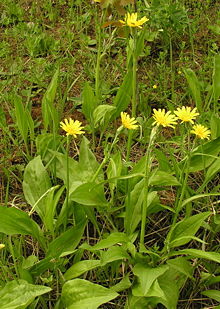Scorzonera humilis
| Viper's grass | |
|---|---|

| |
| Scientific classification | |
| Kingdom: | |
| (unranked): | |
| (unranked): | |
| (unranked): | |
| Order: | |
| Family: | |
| Genus: | |
| Species: | S. humilis
|
| Binomial name | |
| Scorzonera humilis | |
Scorzonera humilis, the viper's-grass,[1] is a perennial plant. In Britain it is a rare plant, restricted to moist meadows, in Dorset and Warwick in England, and in South Wales.
One unique class of stilbenoid derivative was first isolated from S. humilis. They were named the tyrolobibenzyls after Tyrol in the eastern Alps, where the plant was collected.[2]
Description
It differs from goat's-beard, Tragopogon pratensis, in that it has short, pale green bracts, whereas in Goats Beard they are long and pointed.
It grows 7 to 50 cm.
The leaves are unbranched, elliptical-lanceolate.
The flower heads are 2.5 cm wide, and deep yellow in colour. Flowers from May until July.
The achenes are smooth ribbed, beakless, with similar pappus to Tragopogon pratensis.
It exudes a milky juice from its stem.
References
- ^ "BSBI List 2007". Botanical Society of Britain and Ireland. Archived from the original (xls) on 2015-01-25. Retrieved 2014-10-17.
- ^ "Tyrolobibenzyls ‒ Novel secondary metabolites from Scorzonera humilis". Helvetica Chimica Acta (Zürich; Switzerland). 83: 2920–25. 2000. doi:10.1002/1522-2675(20001108)83:11<2920::AID-HLCA2920>3.0.CO;2-5. ISSN 0018-019X.
{{cite journal}}: Unknown parameter|authors=ignored (help) - ^ Blamey, Fitter, Fitter, Marjorie, Richard, Alistair (2003). Wild Flowers of Britain and Ireland. A & C Black - London. pp. 294–295. ISBN 0-7136-5944-0.
{{cite book}}: CS1 maint: multiple names: authors list (link) - ^ Rose, Francis (1981). The Wild Flower Key. Frederick Warne & Co. pp. 390–391. ISBN 0-7232-2419-6.
